![[GAMES & SOFTWARE]](/file/35716/EX CD Rom.iso/issue2_7/images/section_games_sw.gif)
 |
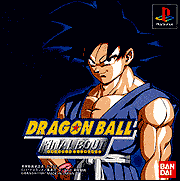
DRAGONBALL FINAL BOUT
SLPS 00949
Copyright © 1997 Bird Studio / Shueisha - Fuji TV - Toei Animation, Bandai
Sony Playstation, 2 players
Now available in Japan
Available in U.S. November 1997
¥5800
— by Joseph Lee
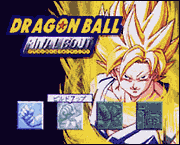

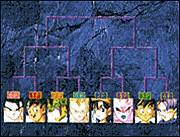 |
 |

This much-anticipated and hyped game from Bandai has finally
arrived. This is the third installment of Dragonball games on the
Sony Playstation by Bandai following DRAGONBALL Z
ULTIMATE BATTLE 22 (27) and DRAGONBALL Z
LEGENDS; not counting the numerous ones already existing on
the SNES and Saturn systems. First named DRAGONBALL
GT to parallel the anime series currently being shown by Fuji
TV in Japan, the name changed at the last moment probably because of
the lack of the majority of characters from DRAGONBALL GT, and the inclusion of some very
specific Z characters for fighting purposes.
 The opening FMV is animated by the DRAGONBALL GT (DBGT) TV series crew, so
it is very nice, and there are no fake-looking graphics as in DBZ UB 22.
Music is done by the same group that did the Cha-la Head-cha-la music of
DRAGONBALL Z and is great..
The opening FMV is animated by the DRAGONBALL GT (DBGT) TV series crew, so
it is very nice, and there are no fake-looking graphics as in DBZ UB 22.
Music is done by the same group that did the Cha-la Head-cha-la music of
DRAGONBALL Z and is great..
 The game is a 3D-ish 2-person fighting game. Players fight in a
plane that stretches vertically from the ground up to a game-limited
height in the sky. Backgrounds are real 3D backgrounds that rotates
around as a fight progresses. It's 3D-ish because fighting remains
in a 2D plane (left-right/up-down) with minimal side-stepping
ability. Nevertheless, the addition of a up-down direction to the
standard left-right/jump 2-d fighting formula makes game play
interesting. There's a health bar, and a psionic power stored bar
which are self-explanatory. Characters can punch, kick, block, and
throw mini ki-balls. Dash to move left/right/up/down. Dash is very
useful considering how slow the characters move when
walking/floating. Also included are move up and move down attacks,
quick get-up, and roll to the side as you get up.
The game is a 3D-ish 2-person fighting game. Players fight in a
plane that stretches vertically from the ground up to a game-limited
height in the sky. Backgrounds are real 3D backgrounds that rotates
around as a fight progresses. It's 3D-ish because fighting remains
in a 2D plane (left-right/up-down) with minimal side-stepping
ability. Nevertheless, the addition of a up-down direction to the
standard left-right/jump 2-d fighting formula makes game play
interesting. There's a health bar, and a psionic power stored bar
which are self-explanatory. Characters can punch, kick, block, and
throw mini ki-balls. Dash to move left/right/up/down. Dash is very
useful considering how slow the characters move when
walking/floating. Also included are move up and move down attacks,
quick get-up, and roll to the side as you get up.
 Carried over from LEGENDS is the Meteor Smash
combo attack system, where a character can initiate an automatic,
super-fast, chainable, multi-hit cheese combo. Meteor smashes
differentiate between punch, kick, and throw power-blast combos,
which are selected at the end of the previous Meteor combo. Super
ki-blasts end the combo chains, and chains link up to 10. Meteors
are difficult to reverse, and just as hard to break (at least the
computer's), but can be turned off in the options.
Carried over from LEGENDS is the Meteor Smash
combo attack system, where a character can initiate an automatic,
super-fast, chainable, multi-hit cheese combo. Meteor smashes
differentiate between punch, kick, and throw power-blast combos,
which are selected at the end of the previous Meteor combo. Super
ki-blasts end the combo chains, and chains link up to 10. Meteors
are difficult to reverse, and just as hard to break (at least the
computer's), but can be turned off in the options.
 The big sprite/polygon super ki-blasts are back as it was in the
SNES games.. They made characters' characteristic super ki-blasts
very impressive, but have seemingly little effect now in DBFB; characters take a step back when hit instead
of being knocked into next week by Gokuu's Kamehameha. One can
defend from a super ki-blast by batting it away, ki-shielding for
half-damage, or challenging back with a super ki-blast. The last
option was quite popular in the SNES games where players would
furiously pound their buttons to see who would win the super
ki-blast push war, and the excitement remains in FINAL BOUT. A small window (indicated by text
flashing on screen) is the time the receiving player gets to respond
to the super ki-blast. It is, however, strange to see time freeze as
the opposing character takes all the time in the world to charge up
for a return ki-blast.
The big sprite/polygon super ki-blasts are back as it was in the
SNES games.. They made characters' characteristic super ki-blasts
very impressive, but have seemingly little effect now in DBFB; characters take a step back when hit instead
of being knocked into next week by Gokuu's Kamehameha. One can
defend from a super ki-blast by batting it away, ki-shielding for
half-damage, or challenging back with a super ki-blast. The last
option was quite popular in the SNES games where players would
furiously pound their buttons to see who would win the super
ki-blast push war, and the excitement remains in FINAL BOUT. A small window (indicated by text
flashing on screen) is the time the receiving player gets to respond
to the super ki-blast. It is, however, strange to see time freeze as
the opposing character takes all the time in the world to charge up
for a return ki-blast.
 Overall, the fighting is very pretty to look at when it starts
playing the Meteor, super-ki, attack-combo sequences, but fighting
response just isn't there. Walking takes forever so you must
dash to get anywhere. Punches/kicks/jumps all have large post-lag
times, and push the hit character back quite a distance, making
multi-hit combos difficult. Fighting is mostly a button-mashing
fest, punctuated by lots of dashing, super ki-blasts, and
attack-specials. Blocking is a joke most of the time. Turning around
takes so long (much like GCentury) that it seems better to dash away
instead. In short, this game is not for the strategic-fight type of
player but fine for DB fans and button-mashers.
Overall, the fighting is very pretty to look at when it starts
playing the Meteor, super-ki, attack-combo sequences, but fighting
response just isn't there. Walking takes forever so you must
dash to get anywhere. Punches/kicks/jumps all have large post-lag
times, and push the hit character back quite a distance, making
multi-hit combos difficult. Fighting is mostly a button-mashing
fest, punctuated by lots of dashing, super ki-blasts, and
attack-specials. Blocking is a joke most of the time. Turning around
takes so long (much like GCentury) that it seems better to dash away
instead. In short, this game is not for the strategic-fight type of
player but fine for DB fans and button-mashers.
 Selectable characters include Son Gokuu (GT, big), Pan, Gokuu (GT,
small), Trunks (GT), Super Saiyajin (SSJ) Vejiita, Gohan (Z),
Perfect Cell, True Buu (Z), Freezer, and Piccolo. Unless specified,
characters come from either DRAGONBALL Z (Z)
or DRAGONBALL GT (GT).
Selectable characters include Son Gokuu (GT, big), Pan, Gokuu (GT,
small), Trunks (GT), Super Saiyajin (SSJ) Vejiita, Gohan (Z),
Perfect Cell, True Buu (Z), Freezer, and Piccolo. Unless specified,
characters come from either DRAGONBALL Z (Z)
or DRAGONBALL GT (GT).
|
 |
|
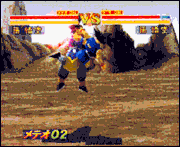
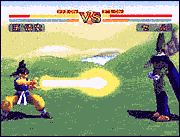
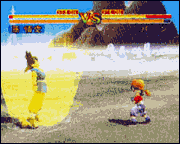
 |
 |
 Hidden characters are SSJ Gokuu (Z), SSJ Gokuu (GT, big), SSJ Future
Trunks (Z), SSJ Vegiito (Z), SSJ4 Gokuu (GT), SSJ GT Gokuu (GT,
small), and SSJ Trunks (GT). The unplayable boss character is Super
Oozaru (Were-Monkey) Bebi from DBGT.
Strangely, with the small subset of some of the most powerful
characters in Dragonball history, the differing power-levels have
absolutely no effect on game play and individual strength/stamina.
Everybody plays the same, albeit with different fighting techniques,
specials, and super ki-blasts. However, the size of the transparent,
rotating 3D-poly models seen when ki-charging actually reflect in
size the known power-level of the charging character (i.e. SSJ4
Gokuu has a very large poly model compared to Pan's or most others).
Hidden characters are SSJ Gokuu (Z), SSJ Gokuu (GT, big), SSJ Future
Trunks (Z), SSJ Vegiito (Z), SSJ4 Gokuu (GT), SSJ GT Gokuu (GT,
small), and SSJ Trunks (GT). The unplayable boss character is Super
Oozaru (Were-Monkey) Bebi from DBGT.
Strangely, with the small subset of some of the most powerful
characters in Dragonball history, the differing power-levels have
absolutely no effect on game play and individual strength/stamina.
Everybody plays the same, albeit with different fighting techniques,
specials, and super ki-blasts. However, the size of the transparent,
rotating 3D-poly models seen when ki-charging actually reflect in
size the known power-level of the charging character (i.e. SSJ4
Gokuu has a very large poly model compared to Pan's or most others).
 There are 4 main options for the game: 2-player battle, 8-player
tournament battle, training build-up mode, and options with a
practice option. Two player mode is the standard
play - through - random - bunch - of - opponents - to - reach - boss, who is Bebi here.
Beating Bebi with almost perfect health lets you challenge SSJ4
Goku. Winning against each hidden character makes them selectable
(except for Bebi). Selected characters talk to each other as the
match loads, which is properly distracting and cute.
There are 4 main options for the game: 2-player battle, 8-player
tournament battle, training build-up mode, and options with a
practice option. Two player mode is the standard
play - through - random - bunch - of - opponents - to - reach - boss, who is Bebi here.
Beating Bebi with almost perfect health lets you challenge SSJ4
Goku. Winning against each hidden character makes them selectable
(except for Bebi). Selected characters talk to each other as the
match loads, which is properly distracting and cute.
 The 8-player tournament is a 3-tiered-levels of 2-player
elimination matches. These 8 players can be either computer or a
real human. Build-mode training is the same idea as DBZ UB 22 where one builds up and saves particular
character's attack power, stamina, speed, and other strengths. The
difference in FINAL BOUT is that you can
build up individual strengths separately such as doing power blasts,
or kicking, punching, etc. Once you've build a strong character,
challenge your friend's built-up character for more fun.
The 8-player tournament is a 3-tiered-levels of 2-player
elimination matches. These 8 players can be either computer or a
real human. Build-mode training is the same idea as DBZ UB 22 where one builds up and saves particular
character's attack power, stamina, speed, and other strengths. The
difference in FINAL BOUT is that you can
build up individual strengths separately such as doing power blasts,
or kicking, punching, etc. Once you've build a strong character,
challenge your friend's built-up character for more fun.
 Graphically, the game has the gouraud 30fps polygon models of the
specific characters pretty much on the mark. Technically, the
models are pretty bad when compared to others, with visible joints
everywhere, and a blocky look. The only place to see Akira
Toriyama's character designs respectably in 3D seems to be TOBAL. Backgrounds here are nice with varied
terrains, and various animated extras such as lightning. The
super-ki blasts are very nice.
Graphically, the game has the gouraud 30fps polygon models of the
specific characters pretty much on the mark. Technically, the
models are pretty bad when compared to others, with visible joints
everywhere, and a blocky look. The only place to see Akira
Toriyama's character designs respectably in 3D seems to be TOBAL. Backgrounds here are nice with varied
terrains, and various animated extras such as lightning. The
super-ki blasts are very nice.
 Music is very well composed in the characteristic vein of previous
Dragonball music--strong on riffs from the guitar, synths, etc, in a
traditional Chinese/Asian meets Western stage/classical/rock style.
Each AD-PCM (non-cd player compatible) track is tailored for its
particular background. A cut above all previous Dragonball game
music. Sound seems to be sampled or taken directly from the original
sources. Ki-charging, doing the super ki-blasts, the FMV, the
original DBZ music group, voices,
exclamations, etc. It definitely gives that anime feel.
Music is very well composed in the characteristic vein of previous
Dragonball music--strong on riffs from the guitar, synths, etc, in a
traditional Chinese/Asian meets Western stage/classical/rock style.
Each AD-PCM (non-cd player compatible) track is tailored for its
particular background. A cut above all previous Dragonball game
music. Sound seems to be sampled or taken directly from the original
sources. Ki-charging, doing the super ki-blasts, the FMV, the
original DBZ music group, voices,
exclamations, etc. It definitely gives that anime feel.
 In summary, FINAL BOUT is a decent
installment in a long line of games. Although it is very pretty to
look at and has moving music, the game play needs some serious work.
Game play drives the rating down, but the nice graphics and
music/sound raise them a little. Pretty typical of a Bandai game.
In summary, FINAL BOUT is a decent
installment in a long line of games. Although it is very pretty to
look at and has moving music, the game play needs some serious work.
Game play drives the rating down, but the nice graphics and
music/sound raise them a little. Pretty typical of a Bandai game.
 The US release is scheduled for November 1997 with dubbed voices,
and FUNimation music, but one would wonders how they would explain
the new GT characters, and why won't they use the English lyric
versions of the songs the original DBZ music
group had done.
The US release is scheduled for November 1997 with dubbed voices,
and FUNimation music, but one would wonders how they would explain
the new GT characters, and why won't they use the English lyric
versions of the songs the original DBZ music
group had done.
Rating: ** (out of 4)
|
 |








